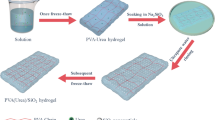Abstract
Poly(3-hydroxybutyrate) (PHB)/chitosan electrospun scaffold was recently prepared for cartilage tissue engineering purpose. The drawback of this scaffold was its low mechanical properties. This study was carried out to see if addition of multi-wall carbon nanotubes (MWNTs) to PHB/chitosan polymeric blend can show better mechanical and structural properties. To do this, three different amounts of MWNTs (0.5, 0.75 and 1 wt%) were added to PHB/chitosan solution. Then, the prepared solution was electrospun. The fibre’s diameter and uniformity were assessed by SEM. The solution components entity authenticity was approved by FTIR. The porosity assessment was illustrated by a porous structure with 81–83% porosity. Water contact angle (WCA) test showed the decrease in contact angle with the increase in MWNTs. Mechanical property results showed the strength of about 4–10 MPa for composites with different percentages of MWNTs, while PHB/chitosan showed the strength of 3 MPa. Actually, the mechanical properties of composite showed higher values when compared to polymeric blend scaffold. All the results reveal that the addition of 1 wt% of MWNTs to the polymeric solution is the most optimal percentage whose values are close to cartilage properties.





Similar content being viewed by others
References
Kaufman M R and Tobias G W 2003 Clin. Plast. Surg. 30 539
Freeman M A R 2011 Adult articulate cartilage
Mort J S and Billington C J 2001 Arthritis Res. 3 337
Hutmacher D 2001 J. Biomater. Sci. Polym. Ed. 2 107
Woodfield T B, Malda J, Wijn J, Peters F, Riesle J and Blitterswijk C A 2004 Biomaterials 25 4149
Hollister S J 2005 Nat. Mater. 4 518
Sadeghi D, Karbasi S, Razavi S, Mohammadi S, Shokrgozar M A and Bonakdar S 2016 J. Appl. Polym. Sci. 133 44171
Dai H 2002 Acc. Chem. Res. 35 1035
Wildgoose G G, Banks E C, Leventis C H and Compton G R 2005 Microchim. Acta 152 187
Balasubramanian K and Burghard M 2005 Small 1 180
Harrison B S and Atala A 2007 Biomaterials 28 344
Kharaziha M, Shin S R, Nikkhah M, Topkaya S N, Masoumi N, Annabi N et al 2014 Biomaterials 35 7346
Shi X F, Hudson J L, Spicer P P, Tour J M, Krishnamoorti R and Mikos A G 2006 Biomacromolecules 7 2237
Fujihara K, Kotaki M and Ramakrishna S 2005 Biomaterials 26 4139
Wang S-F, Shen L, Zhang W-D and Tong Y-J 2005 Biomacromolecules 6 3067
Sell S, Barnes C, Simpson D and Bowlin G 2008 J. Biomed. Mater. Res. Part A 85 115
Mohammadian M and Haughi A K 2014 Bulg. Chem. Commun. 46 545
Boland E D, Coleman B D, Barnes C P, Simpson D G, Wnek G E and Bowlin G L 2005 Acta Biomater. 1 115
Chen G-Q and Wu Q T 2005 Biomaterials 26 6565
Calvo P and Remunan-Lopez C 1997 J. Appl. Polym. Sci. 63 125
Park J M, Wang Z J, Jang J H, Gnidakoung J R N, Lee W I, Park J K et al 2009 Composites. Part A: Appl. Sci. Manuf. 40 1722
Mattioli-Belmonte M, Vozzi G, Whulanza Y, Seggiani M, Fantauzzi V, Orsini G et al 2012 Mater. Sci. Eng. C 32 152
Liu Y L, Chen W H and Chang Y H 2009 Carbohyd. Polym. 76 232
Guo C, Zhou L and Lv J 2013 Polym. Polym. Compos. 21 449
Thambyah A, Nather A and Goh J 2006 Osteoarthr. Cartilage 14 580
Author information
Authors and Affiliations
Corresponding author
Rights and permissions
About this article
Cite this article
Karbasi, S., Alizadeh, Z.M. Effects of multi-wall carbon nanotubes on structural and mechanical properties of poly(3-hydroxybutyrate)/chitosan electrospun scaffolds for cartilage tissue engineering. Bull Mater Sci 40, 1247–1253 (2017). https://doi.org/10.1007/s12034-017-1479-9
Received:
Accepted:
Published:
Issue Date:
DOI: https://doi.org/10.1007/s12034-017-1479-9




